Promising research at the University of Wisconsin Stevens Point-Northern Aquaculture Demonstration Facility
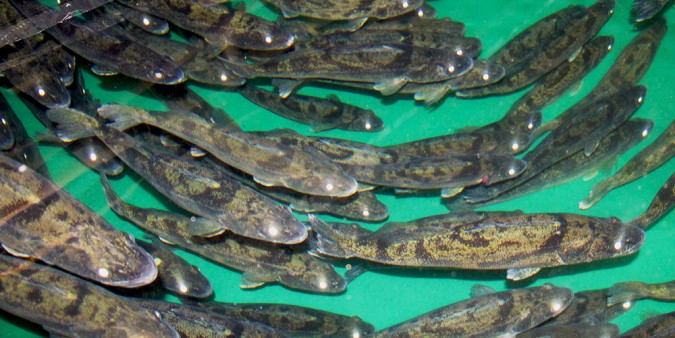
Note: This article is summarized and adapted from an original publication in the September/October 2015 issue of Aquaculture North America. More information on this research work is available at aquaculture.uwsp.
Walleye and sauger
The walleye (Sander vitreus, previously known as Stizostedion vitreum) is a freshwater perciform (family Percidae) fish native to the Northern United States and most of Canada, and a close relative of the European pikeperch (a.k.a. zander). For more than 100 years walleyes have been disseminated and introduced into areas where they previously did not exist; they have significant fishery and ecological importance across their wide geographic ranges, and they are a popular food fish in the north-central United States and Canada as well as being one of the most important commercial and recreational fish species. The sauger (Sander canadensis) is another freshwater perciform fish closely related to the walleye. They are widely distributed and their historical geographic range included the eastern United States west of the Appalachian Mountains, and the southern, central and western United States up into southern Canada.
Aquaculture potential
There has been much research to develop commercial aquaculture of walleye, and also hybrids of walleye and sauger. The hybrid walleye, referred to as a saugeye, is a naturally occurring cross between a female walleye and a male sauger and can also be produced in a hatchery.
Saugeyes have many characteristics suitable to intensive aquaculture production, including the ability to grow the animals at commercial densities through their entire life cycle, from egg to fry to fingerling to market size fish using commercially available feeds, with no live feeds needed. The saugeye has growth rates of up to 2.0 grams/day, which is three to four times higher than those of yellow perch. It exhibits feed conversions of 1.2-1.4:1 during growout, and there are significant markets in the Midwest and high market prices for fillets ($10 to $18 per pound). In addition, there are several potential market sizes, ranging from small fingerlings that can be produced in under six months to larger-sized fish that can take one to three years to produce depending on targeted market size. Walleye and hybrid walleye can be readily cultured in recirculating aquaculture systems and currently showing potential in aquaponics systems.
The indoor system approach by UWSP-NADF
Walleye have been raised for many years by both private and public sectors — mainly in more extensive, outdoor pond systems — but the technology for larval rearing in indoor tank systems has also been developed. Recent investigations at several institutions have studied the seasonal progression of spawning, intensive indoor production of fry and fingerlings, and hybridization as potential ways to improve walleye aquaculture, and now these new technologies are being used to raise these fish to a much larger size in a shorter time.
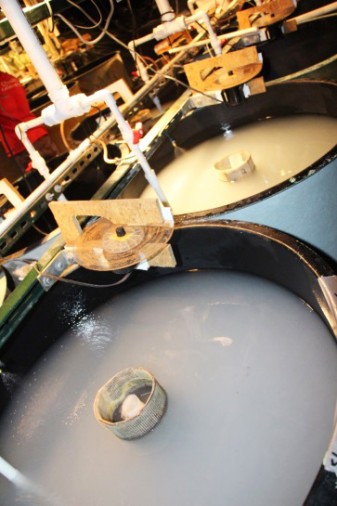
In one of these research programs, researchers at the University of Wisconsin-Stevens Point Northern Aquaculture Demonstration Facility (UWSP-NADF) — along with various collaborators and partners — have been developing methods since 2008 to effectively raise walleye and hybrid walleye (saugeye) using indoor larval fry systems for initial rearing and heated recirculating aquaculture systems (RAS) for growout. They have successfully adapted and modified these technologies to produce pure-bred walleye, pure-bred sauger and hybrid fingerlings utilizing a commercial-scale, water-recycle system operated at 23 degrees-C. And the heated, recycled-water systems are also used for growout to market size.
For these fish species, as well as for many others, fast growth to achieve a large size is crucial for successful commercial production, and among other factors (genetics, nutrition, health management, others), this involves increasing control over the production environment. Indoor production of walleye allows the hatchery or fish farm to control various critical water quality parameters like water temperature, dissolved oxygen and others, resulting in adequate conditions to grow the fish quickly. Another important research objective is to eliminate the need for expensive “pinhead” minnow forage for small walleye fingerlings, in outdoor pond production systems. The cost of this pinhead forage can be as much as 50 percent of the entire forage minnow cost for the larger, extended growth walleyes wanted by many natural resource agencies for their stocking programs. These new indoor technologies have commercial potential for the production of walleye and hybrids utilizing commercial feeds for both stocking and food fish, especially in the Midwest United States.
Broodstock, larval rearing and growout
UWSP-NADF is one of the few U.S. facilities that holds intensively reared, feed-trained walleye and sauger broodstock. These animals are maintained in a warm-water RAS (18 to 24 degrees-C) facility and have been successfully spawned out of season using standard photoperiod and temperature manipulation methodology.
Scientists at the UWSP-NADF have intensively grown walleye and sauger to maturity, and produced broodstock animals that have been successfully spawned during their typical as well as out-of-season spawning from February to June (the usual spawning season for walleye in Wisconsin is April). Both walleye and hybrid walleye eggs have been successfully incubated, hatched and the larvae feed-trained and grown to market size using RAS technology facilities. Commercial diets are used, without any brine shrimp, zooplankton or other natural, live feeds being required.
Using properly set up and operated tank systems, survival rates of up to 60 percent have been reached for the first 30-day larval rearing period. Typically, UWSP-NADF has seen survival rates of 40 to 50 percent throughout this period. Because cannibalism is typical behavior for these fishes, management actions such as size grading in each individual tank is necessary to limit this problem. As in other cannibalistic species, survival rates typically increase significantly as the fish grow and reach larger sizes, and final growout survival rates can reach as high as 95 percent. With the RAS technology and new larval rearing methods developed, hybrid walleye fed commercial diets can reach up to 1 kilogram within 12 months. Furthermore, marketing research shows high sales potential for both pure-bred walleye, for stocking, and hybrid walleye as food fish.
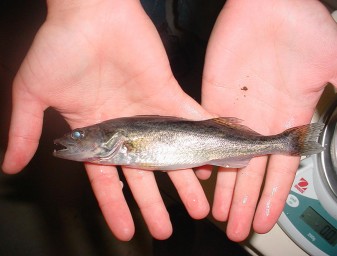
Support and technology transfer
As part of a Small Business Innovative Research Grant (SBIR) Phase I and Phase II, UWSP-NADF has partnered with a private Wisconsin business, Northside Enterprises Inc., to improve and advance walleye and hybrid walleye intensive culture technology for production of both stocking and food fish, respectively. Part of this project is to develop and accelerate the commercialization of these new innovative aquaculture technologies. The purpose of these activities is to show increasing production of advanced walleye fingerlings for stocking of recreational sport fisheries sites, and to further improve integrated systems to produce hybrid walleye from fry to market size in one growing season.
Additionally, technology transfer actions include workshops, tutorials, videos and walleye and hybrid culture manuals for intensively reared walleye and hybrids. UWSP-NADF is already working directly with several Wisconsin aquaculture farms producing walleye and hybrid walleye to support them using these new technologies.
Perspectives
UWSP-NADF research has shown that walleye and hybrid walleye can be successfully raised indoors using early advanced spawning, incubation and rearing techniques. The UWSP-NADF recycle system has produced market-size hybrid walleye (up to 1 kg) in one growing season from fingerling averaging 0.95 grams at stocking, at average tank densities of 34-kg/m³. The data also suggests that growth rates of hybrid walleye are higher than pure-bred walleye. Processing yields to fillets of greater than 50 percent and initial marketing studies indicate good aquaculture potential and high demand for hybrid walleye as food fish. We expect that these studies and other research efforts will successfully demonstrate improvements in the economics of walleye and hybrid walleye production and further support their commercial aquaculture production.
Authors
-
Emma Wiermaa
Outreach Specialist
University of Wisconsin-Stevens Point, Northern Aquaculture Demonstration Facility
36445 State Hwy 13, P.O. Box 165
Bayfield, WI 54814 USA
[117,100,101,46,112,115,119,117,64,97,97,109,114,101,105,87,46,97,109,109,69]
-
Gregory Fischer
Facility Manager
University of Wisconsin-Stevens Point, Northern Aquaculture Demonstration Facility
36445 State Hwy 13, P.O. Box 165
Bayfield, WI 54814 USA[117,100,101,46,112,115,119,117,64,114,101,104,99,115,105,102,103]
Tagged With
Related Posts
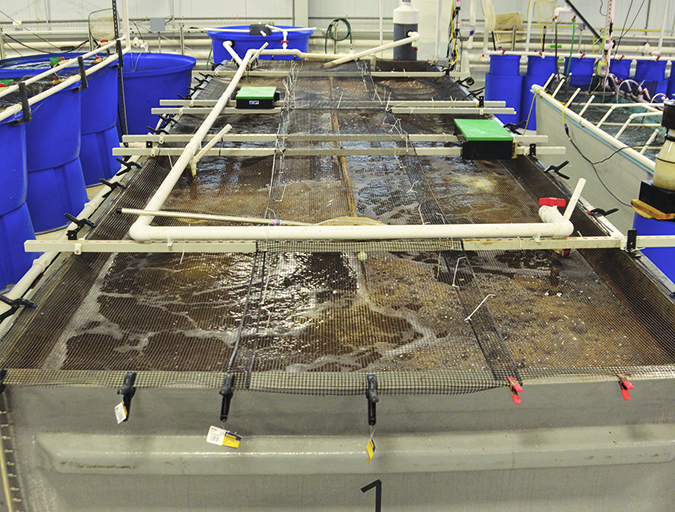
Intelligence
Indoor-raised shrimp find potential market in Kentucky test
By raising shrimp in a closed building, producers can increase biosecurity, produce shrimp more consistently, grow shrimp year-round and locate production centers near markets. Chefs and consumers were very accepting of whole fresh shrimp, offered at a farmers market, that was farmed indoors in Kentucky.
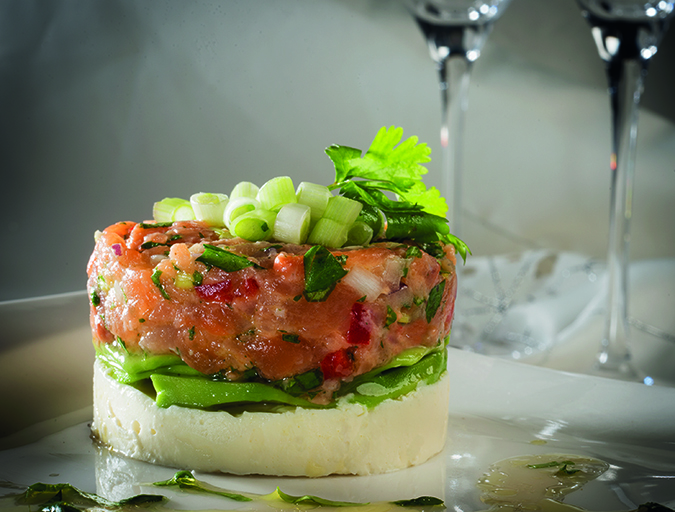
Innovation & Investment
Matorka aims to unearth innovation with Arctic charr
A new and ambitious Iceland company is about to construct what it claims will be the world’s largest land-based salmonid farm. What sets Matorka’s Arctic char farm apart is its ability to tap into natural resources unique to the island nation.
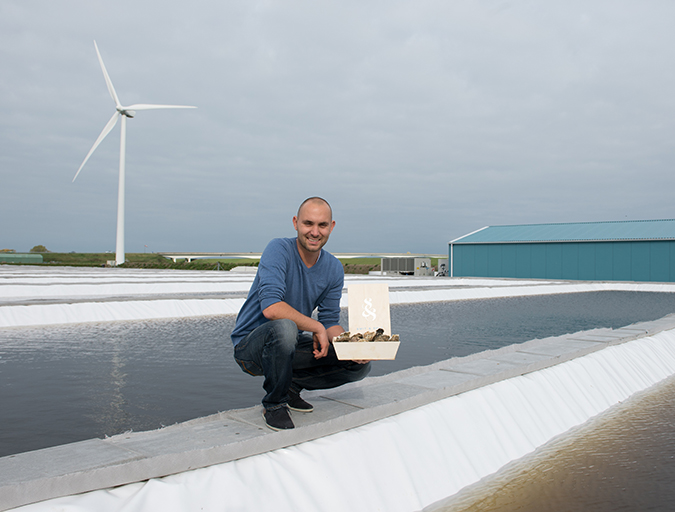
Intelligence
Dutch shellfish farmers bringing the sea onto land
Bivalve shellfish culture is a low-impact form of protein production, and in many cases is a net-positive for water quality. So why move it indoors? Smit & Smit in the Netherlands has a good argument for doing so.
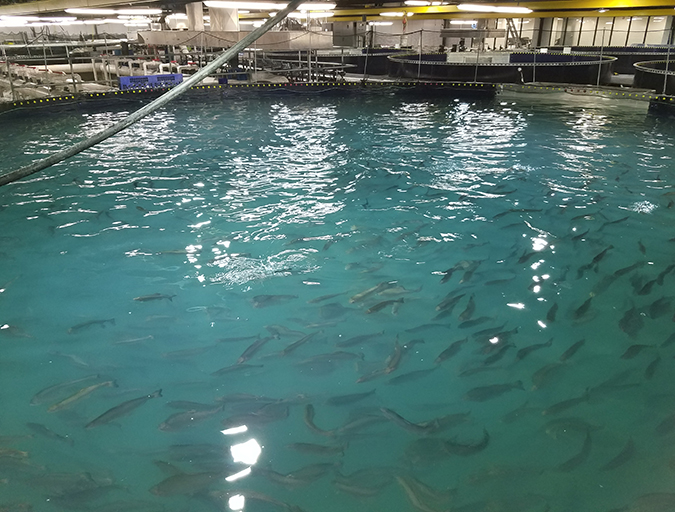
Intelligence
A land grab for salmon (and shrimp) in upstate New York
The operators of Hudson Valley Fish Farm see their inland locale as a pilot to prove that land-based fish farming, located in close proximity to major metropolitan markets, can be successful.


